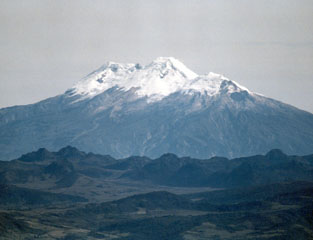Report on Nevado del Huila (Colombia) — 9 April-15 April 2008
Smithsonian Institution / US Geological Survey
Weekly Volcanic Activity Report, 9 April-15 April 2008
Managing Editor: Sally Sennert.
Please cite this report as:
Global Volcanism Program, 2008. Report on Nevado del Huila (Colombia) (Sennert, S, ed.). Weekly Volcanic Activity Report, 9 April-15 April 2008. Smithsonian Institution and US Geological Survey.
Nevado del Huila
Colombia
2.93°N, 76.03°W; summit elev. 5364 m
All times are local (unless otherwise noted)
Seismicity from Nevado del Huila increased during 9-12 April then again on 13 April, prompting INGEOMINAS to raise the Alert Level to Orange (the second highest level on a 4-color scale). During 13-14 April, seismic signals possibly indicated an eruption. According to news articles, authorities ordered about 15,000 people to evacuate. On 14 April at 2325, the Alert Level was raised to Red, the highest level, based on the seismicity. Seismic events decreased in number and intensity in the early evening of 15 April; the Alert Level was lowered to Orange. Weather inhibited visual observations and overflights of the summit.
Geological Summary. Nevado del Huila, the highest peak in the Colombian Andes, is an elongated N-S-trending volcanic chain mantled by a glacier icecap. The andesitic-dacitic volcano was constructed within a 10-km-wide caldera. Volcanism at Nevado del Huila has produced six volcanic cones whose ages in general migrated from south to north. The high point of the complex is Pico Central. Two glacier-free lava domes lie at the southern end of the volcanic complex. The first historical activity was an explosive eruption in the mid-16th century. Long-term, persistent steam columns had risen from Pico Central prior to the next eruption in 2007, when explosive activity was accompanied by damaging mudflows.
Sources: Servicio Geológico Colombiano (SGC), CNN

